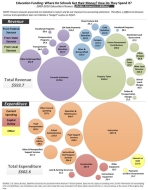
An official website of the United States government
Here’s how you know
Official websites use .gov
A .gov website belongs to an official government organization in the United States.
Secure .gov websites use HTTPS
A lock (
) or https:// means you’ve safely connected to the .gov website. Share sensitive information only on official, secure websites.
-
//
- Census.gov /
- Newsroom /
- Census Blogs /
- Random Samplings /
- Education Funding: Where do Schools Get Their Money?
Education Funding: Where do Schools Get Their Money? How do They Spend it?
Education Funding: Where do Schools Get Their Money? How do They Spend it?
Statistics released today by the Census Bureau provide a detailed look at how public elementary-secondary school systems are funded and how they provide the education and services for our nation’s children. These data, released annually, provide information on revenues, spending, debt, and assets of our public school systems.
Total spending by public elementary-secondary school systems in fiscal year 2010 was $602.6 billion, a 0.4 percent decrease from 2009. Total current spending was $524.0 billion, of which $317.8 billion went to instruction and $179.0 billion to support services, such as school bus transportation and the operation and maintenance of school buildings and equipment. Per pupil current expenditures amounted to $10,615 with great variation among the states. The District of Columbia led all states at $18,667 followed by New York ($18,618).
Revenues for our nation’s public elementary-secondary school systems come primarily from local government sources of revenue (when combined) for a total of $261.4 billion in fiscal year 2010. When revenue sources are looked at independently, state sources to schools of formula assistance monies ($176.6 billion) are the largest single source of funding followed closely by local government receipts of property tax monies ($169.4 billion).
Data released cover public elementary-secondary school systems at the national, state, and school district levels. The detailed tables include statistics on spending (such as instruction, administration, operations, and student transportation) and statistics on funding (such as receipts from property tax, formula assistance, and special education grants). For more details, see Public Education Finances: 2010.
Share
 Yes
Yes
 No
NoComments or suggestions?


Top

